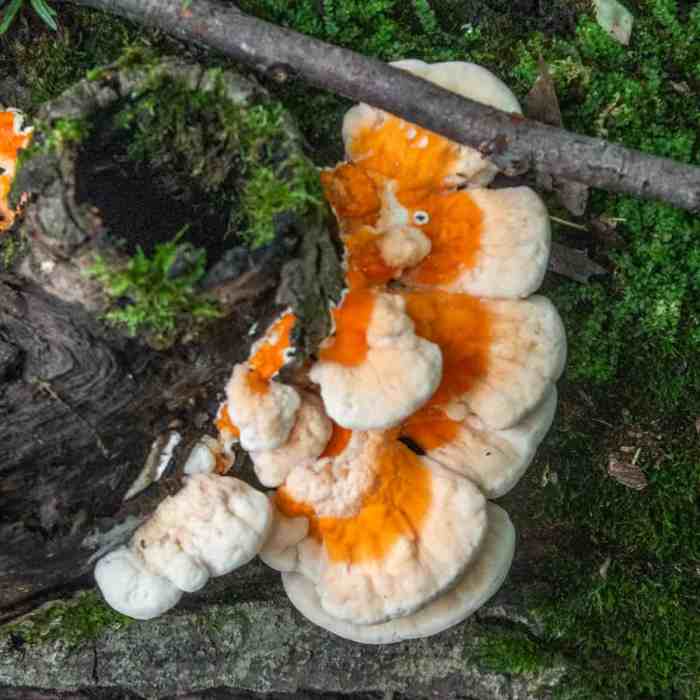
Chicken of the woods recipe, an extraordinary culinary journey awaits you. Discover the unique flavors and textures of this wild mushroom as we embark on a delectable adventure.
From the vibrant hues that adorn its surface to the versatility it brings to your kitchen, chicken of the woods is a true culinary gem. Join us as we explore its nutritional wonders, safety considerations, and a myriad of mouthwatering recipes that will tantalize your taste buds.
Chicken of the Woods Identification

Chicken of the woods is a vibrant and easily recognizable mushroom that is a popular edible species among mushroom enthusiasts. It is characterized by its distinctive appearance and unique growth pattern.
Physical Characteristics
- Shape:Chicken of the woods typically grows in shelf-like or bracket-like formations, with multiple overlapping layers or tiers. It can range in size from a few inches to over a foot in width.
- Color:The mushroom’s upper surface is usually a bright orange or yellow, resembling the plumage of a chicken, hence its name. The underside, where the spores are produced, is typically white or cream-colored.
- Texture:When fresh, chicken of the woods has a firm and meaty texture, making it suitable for various cooking methods. However, it can become tough and rubbery if it is not cooked properly.
Habitat and Seasonality
Chicken of the woods is a parasitic fungus that grows on the trunks of dead or dying hardwood trees, particularly oaks. It is commonly found in North America, Europe, and Asia. The mushroom is typically in season from late summer to early fall.
Nutritional Value and Health Benefits

Chicken of the woods is a nutritionally rich mushroom, boasting an impressive profile of protein, fiber, and vitamins. Every 100 grams of fresh chicken of the woods contains approximately 3.3 grams of protein, 7.2 grams of fiber, and is a good source of vitamins B1, B2, B3, and C.
Antioxidant and Anti-inflammatory Properties
Chicken of the woods is gaining recognition for its potential health benefits, particularly its antioxidant and anti-inflammatory properties. Studies have shown that it contains high levels of antioxidants, such as ergothioneine and phenols, which help protect cells from damage caused by free radicals.
Additionally, chicken of the woods exhibits anti-inflammatory properties, making it a potential dietary supplement for individuals with inflammatory conditions.
Culinary Applications

Chicken of the woods is a versatile mushroom with a meaty texture and savory flavor. It can be used in a variety of dishes, from soups and stews to stir-fries and grilled entrees. Here are a few ideas for how to cook chicken of the woods:
Before cooking, clean the chicken of the woods by removing any dirt or debris. Cut the mushroom into bite-sized pieces and cook it as desired. Chicken of the woods can be cooked fresh or dried. Dried chicken of the woods has a more intense flavor and can be rehydrated before using.
Soups and Stews
Chicken of the woods is a great addition to soups and stews. It adds a meaty texture and savory flavor to the dish. To use chicken of the woods in soup or stew, simply add it to the pot along with the other ingredients.
Chicken of the woods can also be used to make a vegetarian or vegan broth.
Stir-fries
Chicken of the woods can be used in stir-fries in place of meat. It is a good source of protein and fiber, and it has a meaty texture that will hold up well in a stir-fry. To use chicken of the woods in a stir-fry, simply cut it into bite-sized pieces and add it to the pan along with the other ingredients.
Grilled entrees
Chicken of the woods can be grilled as an entree. It is a good source of protein and fiber, and it has a meaty texture that will grill well. To grill chicken of the woods, simply brush it with olive oil and grill it over medium heat until it is cooked through.
Storing and preserving
Chicken of the woods can be stored in the refrigerator for up to a week. It can also be dried and stored in an airtight container for up to a year. To dry chicken of the woods, simply cut it into thin slices and place it on a baking sheet in a warm, dry place.
Once the chicken of the woods is dry, it can be stored in an airtight container until ready to use.
Safety Considerations
Properly identifying chicken of the woods is crucial to avoid confusion with poisonous lookalikes. Carefully examine the mushroom’s physical characteristics, such as its size, shape, color, and texture. It’s always advisable to consult with an experienced mushroom forager or refer to reliable field guides.
Foraging and Harvesting Guidelines
When foraging for chicken of the woods, choose healthy specimens with firm, bright-colored flesh. Avoid mushrooms growing on dead or decaying trees, as they may be contaminated. Harvest the mushrooms by carefully cutting them from the tree, leaving the base intact.
Potential Risks and Precautions
Consuming raw chicken of the woods can cause gastrointestinal distress in some individuals. It’s recommended to cook the mushrooms thoroughly before eating them. Additionally, some people may experience allergic reactions to chicken of the woods. If you have any concerns or allergies, consult with a healthcare professional before consuming the mushrooms.
Additional Information

Delve deeper into the fascinating world of chicken of the woods with these valuable resources.
Comparison with Other Edible Wild Mushrooms, Chicken of the woods recipe
Chicken of the woods shares certain similarities and distinctions with other edible wild mushrooms. Explore the table below for a detailed comparison:
| Feature | Chicken of the Woods | Other Edible Wild Mushrooms |
|---|---|---|
| Shape | Bracket-shaped, shelf-like | Varies depending on species (e.g., cap, funnel, trumpet) |
| Color | Orange to yellow | Varies widely (e.g., white, brown, blue, purple) |
| Habitat | On dead or decaying hardwood trees | Various habitats, including forests, meadows, and lawns |
| Flavor | Chicken-like, savory | Ranges from mild to nutty, earthy, or fruity |
| Texture | Tender when young, tough when mature | Varies from tender to firm or chewy |
Additional Resources
- MushroomExpert.com: Laetiporus sulphureus
- Foraging Texas: Chicken of the Woods Mushroom
- Mykoweb: Laetiporus sulphureus
- Facebook Group: Chicken of the Woods Mushroom
Summary

As we bid farewell to our exploration of chicken of the woods, let us savor the memories of its culinary delights. Remember, this wild mushroom is not just a tasty treat but also a source of nourishment and a testament to nature’s bounty.
May your future culinary adventures be filled with the vibrant colors and unforgettable flavors of chicken of the woods.
FAQ Summary: Chicken Of The Woods Recipe
What does chicken of the woods taste like?
Chicken of the woods has a mild, slightly nutty flavor that can be compared to chicken or crab meat.
Is chicken of the woods safe to eat raw?
No, chicken of the woods should not be eaten raw as it can cause stomach upset. It should be cooked thoroughly before consumption.
How can I store chicken of the woods?
Chicken of the woods can be stored in the refrigerator for up to 5 days or in the freezer for up to 6 months.





